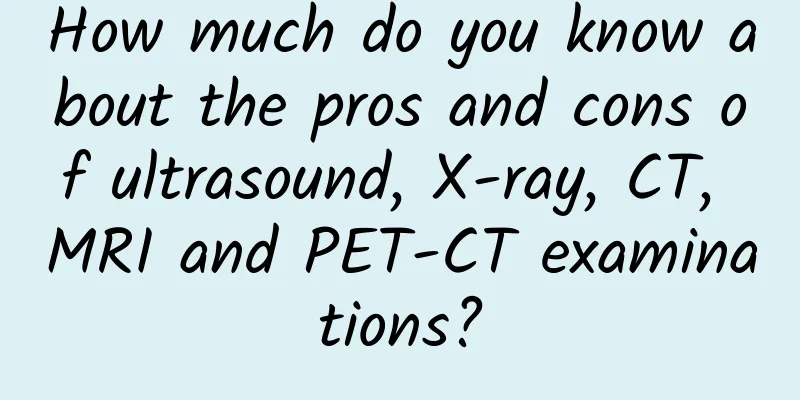How much do you know about the pros and cons of ultrasound, X-ray, CT, MRI and PET-CT examinations?

|
In recent years, the rapid development of medical imaging has achieved a transformation from anatomical imaging to functional and molecular imaging, and from two-dimensional to three-dimensional imaging, and even four-dimensional imaging, which has enhanced people's understanding of the nature of diseases and their evolution, and greatly improved the accuracy of medical imaging diagnosis. With the rapid development of medical imaging, people's understanding of the early detection, early diagnosis and early treatment of diseases themselves, as well as modern medicine, has also changed from being in the dark to being bright. So, how much do you know about the characteristics, uses, advantages and disadvantages of ultrasound, X-ray, CT, MRI and PET-CT in clinical practice? This article will explain them to you one by one. 1. Characteristics and uses of ultrasound, X-ray, CT, MRI and PET-CT 1. Ultrasound: Ultrasound is an imaging technique that uses high-frequency sound waves to produce images through the echo of tissues to explore the internal tissue structure of the body. It can clearly show the structure and morphology of soft tissue organs such as the liver, gallbladder, blood vessels, and uterus. It can usually be divided into two-dimensional ultrasound and three-dimensional ultrasound. Ultrasound has no radiation, is harmless to the body, is easy to operate, and is relatively inexpensive; but it cannot penetrate denser structural tissues such as bones and air, and is not suitable for examining bones, lungs, and chest cavities. Uses: Commonly used for pregnancy tests, abdominal diseases, heart disease, urinary system diseases, etc. 2. X-ray: X-ray is an examination method that uses radiation to penetrate objects and presents different images according to the different degrees of blocking and absorption of X-rays by different tissues. It can show the shape and structure of hard tissues and cavities such as bones, chest cavity, lungs, etc. X-ray examination is mainly used for preliminary examination of some diseases, which is convenient for finding tissue structures with obvious lesions. This examination takes a short time and is cheap. It is the preferred examination method for initial screening of diseases. However, X-ray examination may be affected by overlap and there are also radiation hazards. It should be used with caution for pregnant women and children. Uses: Commonly used to examine bone, tooth, lung diseases, etc. 3. Computed tomography (CT): CT is a tomographic imaging technology based on X-rays and using spiral scanning. Its principle is to diagnose diseases based on the degree of energy attenuation in different tissues. X-rays are used to scan slices of the human body in different directions, and computer processing is used to generate high-quality three-dimensional images and multi-plane cross-sectional images, and to accurately locate them. CT has higher density resolution and accuracy than X-rays, and can display anatomical details and layers more clearly. However, CT has a higher radiation dose than X-rays, and repeated scans in a short period of time have certain potential harm to the body. Uses: Commonly used to examine tumors, brain diseases, vascular diseases, etc. 4. Magnetic resonance imaging (MRI): MRI is an imaging technique based on magnetic field, pulse gradient and radio waves. It has high sensitivity and detection rate for soft tissue lesions such as brain, nerves, muscles, joints, etc., and has incomparable advantages over X-ray and CT in diagnosing soft tissue lesions and spinal cord injuries. MRI provides more information than other imaging techniques in medical imaging. It can directly produce more detailed tomographic images in sagittal, coronal, transverse and various oblique planes. It can show more anatomical details by using multi-parameter imaging, and has high soft tissue resolution. MRI examination does not produce artifacts, no ionizing radiation, and has no effect on the body; but it takes a long time to perform motionless examinations, and there are certain limitations for some patients (such as patients with stainless steel materials, heart disease or implanted pacemakers). MRI is better than CT in diagnosing the nervous system, digestive system, urinary system and reproductive system. It can perform cardiac and vascular imaging without contrast agents, but the cost is relatively expensive compared to other examinations. Uses: It is often used to examine the brain, joints, spine, etc. 5. Positron emission computed tomography (PET): PET-CT is an imaging technology that combines positron emission tomography and CT technology to display the metabolism, function, blood flow, cell proliferation and receptor distribution of tissue cells at the molecular level. It is called "in vivo biochemical imaging" by replacing spatial position and energy signals and reconstructing different tomographic images through computer processing to display complete images of human metabolism and structural information. PET-CT plays an important role in the diagnosis, staging and efficacy evaluation of benign and malignant diseases by virtue of its high sensitivity, high spatial resolution and wide imaging range. It is widely used in tumors, cardiovascular diseases, neurological function lesions and other aspects, providing clinical physiological and pathological diagnostic information for diseases. However, PET-CT also has defects, such as high examination costs, low tissue resolution, strong drug dependence, etc., and its clinical application and development are limited to a certain extent. Uses: Commonly used in the diagnosis of tumors, inflammation and other aspects. 2. Do X-rays, CT, MRI and PET-CT cause radiation damage? In clinical work, many people worry about the impact of radiation on the body before undergoing imaging examinations. X-rays and CT belong to ionizing radiation. In essence, they are both images formed by X-rays. The single radiation dose is low. Only repeated overdose exposure in a short period of time will cause harm to the human body. With people's understanding of radiation and the continuous development of X-ray technology, equipment is constantly updated, parameters are continuously optimized, and low-dose imaging examinations are applied. For example, low-dose CT significantly reduces the radiation dose of CT. MRI belongs to electromagnetic radiation, and the imaging principle is related to the electromagnetic field. At present, there is no direct evidence of harm to the human body. The radiation caused by PET-CT examination mainly comes from CT and radioactive tracers. With the advancement of science and technology, medical equipment is updated and iterated, and PET data reconstruction is optimized to reduce the radiation dose of tracers, thereby achieving low-dose scanning. In addition, the country has strict management standards for the radiation dose of various inspection equipment. During the inspection, professional radiologists operate according to the regulations, control the radiation intensity and contact distance within the standard range, and shield and protect non-inspection parts and sensitive organs, so as to prevent the examinee from unnecessary radiation. 3. Conclusion In summary, various medical imaging technologies have their scope of application and advantages and disadvantages. Ultrasound is suitable for the examination of superficial and hollow organs, X-ray is suitable for the examination of bone and lung diseases, CT is suitable for whole-body scans, MRI is suitable for the examination of soft tissue and brain diseases, and PET-CT is suitable for the diagnosis of diseases such as tumors and inflammation. Clinicians need to select the most appropriate imaging examination based on the patient's specific condition, and at the same time combine different imaging methods to complement each other's advantages and improve the sensitivity and specificity of diagnosis, staging and treatment of common clinical diseases. In this way, advanced medical imaging technology can truly serve the clinic and benefit mankind. Author: Liu Tao Unit: Department of Spine Surgery, Shanghai Fourth People's Hospital, Tongji University |
<<: Technology "cultivates" new things丨Beidou, 5G and autonomous driving are also used in the fields
>>: Beware! Chronic fatigue syndrome may bring big trouble! Check to see if you are infected
Recommend
No food or water for 40 days! This fish dad's way of raising a baby is shocking...
Identity Profile: Who is Otaki Six-line Fish? Sci...
Payment system design: How does Yingke guide users to pay for the anchors step by step?
Two days ago, Fu Yuanhui made her first live broa...
Subaru expands recall of 4 models due to Takata airbag issue
Recently, Subaru Automobile (China) Co., Ltd. fil...
Over-emphasizing traffic in social marketing is a taboo
Today, I am helping a leading betel nut brand wit...
Xiaomu C4D Product Rendering 2021 Redshift Course [HD Quality with Materials]
Xiaomu C4D Product Rendering 2021 Redshift Course...
Understand these 5 types of activity classification to make operations more efficient
Clarifying the purpose of an event should be the ...
Deserts are not controlled, but protected? | World Day to Combat Desertification and Drought
In recent years, my country has made considerable...
China Passenger Car Association & Cree Consulting: Insights into the Three-Electric System of New Energy Vehicles in October 2022
Trends in China's New Energy Vehicle Market I...
Interpretation of APP development postures in 3 major mobile application methods
We all know the current mainstream mobile applica...
Do you feel dizzy when you stand up after squatting for a long time? It may not be hypoglycemia! This disease is very common →
Have you ever had Such experience After squatting...
National Safety Production Month丨What should we prepare for floods?
At present, many parts of my country have been hi...
Talking about IP operation from the perspective of Perfect Diary’s marketing
Nowadays, with the continuous development of bran...
Data analysis of Internet finance platforms: These three models are enough
Since the operations department is the department...
New App Promotion Techniques: Video Promotion Makes Your App Popular Overnight
Everyone on the Internet is familiar with Chai Ji...
Make iPhone fingerprint unlocking more sensitive | Qinggong
I believe everyone is familiar with "fingerp...









